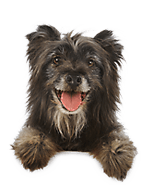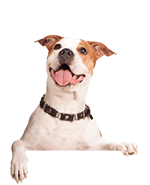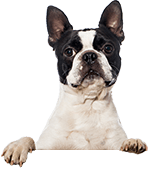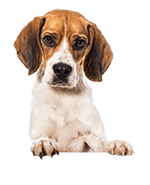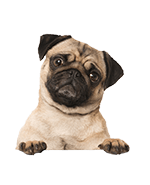- What should I bring on a dog walk?
- What should I wear on a dog walk?
- How do I get a dog ready to walk?
- Am I allowed to let other people/dogs say hi to the dog I’m walking?
- What are some other ways to keep a dog safe on walks?
- What do I do if a dog picks up something in their mouth on a walk?
- What do I do if a dog is pulling really hard on walks?
- What if a dog doesn’t want to walk?
- What do I do after a walk?
- How do I tell a client if something went wrong during a walk/visit?
What should I bring on a dog walk?
Make sure to bring your phone with you on walks. Not only is this necessary to track your walk route for your journal report, you may need it while out on a walk to ask the team for help or to refer to a support article (like this one!). However, while out on walks, we highly recommend you avoid using your phone as much as possible. Ideally, all attention should be on dogs during walks. If you absolutely have to go on your phone (for help/emergency purposes), we suggest that you STOP first, then go on your phone, then put your phone away before resuming. Going on your phone can also cause journal map issues, making your walk route look inaccurate on the journal map.
Store as many poop bags as possible in our company drawstring bag (or just on you in general). It’s beneficial to get into the habit of checking for a “poop bag count” after the end of each workday and/or before the start of each workday. Never assume that a client will have bags available for you to use.
You should always have water with you on walks as well, for you and the pup! Not only is this an essential during Summer Walks to help keep everyone cool, it’s important to stay hydrated all year round during walks!
You may also find it helpful to bring the following with you in your drawstring bag:
- Towel(s) – for Rainy Day Walks, for snow during Winter Walks, and for cooling off pups during Summer Walks
- Dog bowl for water
- Umbrella
- Dog toys/tennis balls
- Extra layers for yourself
- Safety vest for yourself
- Treats – only give treats provided by client; do not give your own treats due to unforeseen dietary restrictions!
- Tweezers – to remove splinters or ticks
- Sunscreen and other sun protection – more listed in Summer Walks
- Bug spray
What should I wear on a dog walk?
Regarding attire, it is important that you are comfortable in any and all weather conditions.
If it’s chilly/cold outside:
- Wear more layers than you actually think you need
- If you get too warm, you can remove layers to your desire.
- If you have little layers to work with from the start, you are likely to be quite miserably cold while out on walks, which can lead to wanting to cut the walk short, being impatient, frustrated, etc.
- Learn more in Winter Walks!
On rainy or snowy days:
- Bring extra socks, should the ones you’re wearing get wet. Nothing more miserable than wearing cold, soggy socks all day long!
- Have a waterproof layer on your body and feet to keep moisture off of them and keep them warm
On warm days:
- Wear short sleeves
- Load up on the sunscreen
- Wear sun protective garments like sunglasses and a hat
How do I get a dog ready to walk?
For commonly used gear on walks (collars, harnesses, leashes) follow the steps below to ensure the dog is safe and comfortable while wearing them:
- If applicable, check that the collar is on properly. The collar will fit best if you are able to slip 2 fingers ONLY between collar and dog’s neck.
- If applicable, check that the harness is on properly. The harness will fit best if you are able to slip 2 fingers ONLY between harness and dog’s body.
- Check that the leash is attached to the collar’s or harness’s D-ring, and NOT the collar’s ID tag wire.
- Double check that everything is secured by pulling up on the leash when it’s attached to the collar or harness.
- Check that all gear is intact. Any rips, tears, or flimsy pieces could cause a pup to escape you easily with one good pull!
Please know that there may be other you’re asked to use, depending on the client’s exact needs! Many clients have weather-specific gear that you may utilize on your Summer Walks or Winter Walks! Check all client notes in each pet’s profile on Precise Petcare to make sure they are wearing everything that the client is asking them to wear! Some examples of other walking gear include:
- Coat/Sweater
- Scarf/Bandana
- Rain Jacket
- Booties
- Paw Ointment
- Safety Vest/Lights
Best Practice: If it is in the profile notes and applicable to the walking conditions, the client will then expect you to use it! Also, keep a sharp eye out for notes regarding equipment you must REMOVE before walks, like invisible fence collars. This is included in our Service Checklists > Dog Walking Checklist to help you remember!
Am I allowed to let other people/dogs say hi to the dog I’m walking?
You are bound to cross paths with other people or dogs that are excited to say hello to the pup in your care. But, your top priority in any situation involving interactions with others should be safety. This is why we recommend the following:
Avoid interactions with other dogs while you’re out on walks. No matter how friendly/harmless another pup may seem, you never know what their behavior is like if you approach them. If you see a dog coming towards you and the dog you’re walking, it would be best to move in the other direction, cross the street, etc. As soon as you catch sight of a dog in the distance, the sooner the better it is to start walking elsewhere. Stay as far away as possible!
If someone approaches with their dog, saying that their dog is friendly towards other dogs and/or wants to initiate some kind of interaction between their dog and the one you’re walking, you may kindly inform them that you are just the dog walker for the dog and don’t want to take any risks with them interacting. For example, you could say: “This isn’t my dog, I’m just the dog walker. I’m sure they’d love to meet each other, but I don’t wanna take any risks of anyone getting injured or hurt. Thanks for your understanding!”
Avoid letting strangers pet the dog in your care while out on walks. If someone approaches you, asking to pet the dog you’re walking, you can refer to the tip above.
If a stray/loose dog approaches you and the dog in your care while out on a walk, you may consider bringing the dog in close/shortening the leash and standing in between the two pups (if they are already a distance away from each other). The goal is to create space between your dog and the loose dog. Please be aware that this is dangerous if the two dogs are already going at it with one another; getting in the middle of a dog fight may result in you being injured or harmed by any of the dogs involved. You can also change directions or crossing the street to avoid the loose dog. Avoiding engaging with the stray/loose pup (calling out to them, bending down to them) so as not to “invite” them over. If the dog is already close to you, you can use commands such as “stay” and “no” in a very dominant tone of voice, with hopes that they will pick up on your disapproval and stay away. Keeping a sharp eye out in every direction so you can prepare yourself should the dog (or another loose dog) approach again.
In situations that have escalated (in which fights have broken out), you might find it helpful to use loud or high-pitched noises, a long stick, or an umbrella to scare off the dog. Learn more in Emergencies.
What are some other ways to keep a dog safe on walks?
Perform an environment safety check as often as you need! To do so, take note of the following:
- Is the temperature outside comfortable? See Summer Walks and Winter Walks for more info!
- Is the pavement cool enough to walk on, if it’s in the hot summer months? See tips in Summer Walks to test it out!
- Is there a lot of snow/ice on the ground? If so, see what to do in Winter Walks.
- Are there other dogs in the immediate area? If so, wait a minute to let them pass and avoid any and all close interactions!
- Are there sudden loud noises that could scare or frighten the dog you’re walking, like a garbage truck or ambulance? If so, wait a minute to let them pass.
- Are there unsafe substances, toxins, chemicals, or glass on the ground? Please make sure to avoid these as you step out to enjoy your stroll!
You should also take weather into account while assessing the environment for a walk. Here are some things you can do to keep you and the dog safe and comfortable while walking in harsh weather:
- Avoid puddles and mud during rainy days
- Seek shelter and use your umbrella during rainy days
- Avoid snow, ice, and salt as much as possible during snowy days
- Seek out shade on sunny days
- Avoid hot pavement on sunny days
What do I do if a dog picks up something in their mouth on a walk?
If the dog picks up something in his/her mouth while out on a walk, you may consider:
- Avoiding going straight for the mouth to remove the object. You never know if a dog is territorial over things they pick up/possess!Using commands to get the dog to stop the behavior (commands listed in pet’s profile in Precise Petcare are preferred!).
- Using commands like “no” or “drop it” at your discretion. If you are firm enough with the dog, they will hopefully pick up on your disapproval and comply/drop it.
- Sometimes though, they’re so quick about picking up, chewing, and swallowing! If this is the case, and it’s an emergency where the dog is choking, you may choose to call the vet (in Precise Petcare notes). You are also encouraged to contact the team and see what we can all do to help you! Please use any and all online support articles to assist you! If you choose to remove an object from a dog’s mouth, we recommend using careful steps to ensure you don’t get bit!
- Proactively looking out for objects in your path that the dog may pick up. Steer clear of these objects, so that you can avoid the problem from happening at all.
For every dog’s safety, we highly encourage that you are on the look out for any dangerous substances on the ground that may cause injury or illness, such as broken glass, fertilizer (small blue pellets on new grass, fresh mulch), or rotten food/garbage. If you see any of these things, we recommend the following:
- Shorten the leash and walk at least 4 feet away from the object (the further the better).
- If necessary, cross the street or change directions to fully avoid the potential hazard.
- Remain diligent, there could be more potentially dangerous substances in the surrounding areas.
**If you suspect a dog has consumed something toxic/harmful on a walk, the most helpful information for you will be in Emergencies**
What do I do if a dog is pulling really hard on walks?
First, ensure that you keep a secure grip on the leash and are ready to take control of the dog at a moment’s notice while walking. More info on specific leash types can be found in Leashes.
- If walking with a flat lead, check that you have a secure grip on the leash by using the fingerlock method.
- If walking with a retractable lead, check that you have a firm grip on the handle and can easily reach the stop button.
- If walking with a shoulder-strap lead, check that it is comfortable and fitted across your body (like a seatbelt), and keep one hand on the lead at all times for maximum control.
- Shorten any leash as much as possible when you see another dog and/or person out on a walk.
At HNP, we see a good number of dogs that love to pull on walks. It could be due to a number of reasons, including high energy, excitement to walk, reactiveness to other dogs and people, a strong desire to search for smells, a strong desire to chase small animals, and more. Here is what you can do to discourage this behavior and set you and the dog up for a successful walk!
Check that the dog has walking gear that discourages pulling, like a front-clip harness or a head-halter harness. More info on those in Harnesses. Also, dogs that pull a lot should NOT be utilizing a retractable lead, since it is very easy for them to quickly travel away from you, giving you less control over them. Retractables can also cause friction burn for both dogs and walkers. Equipment is the most important part of discouraging pulling in dogs, as they physically correct the behavior in a way that isn’t harmful or painful. Sometimes, the change in behavior is instant from this alone! If you think the dog could benefit from a change in walking gear to help with pulling, tell the client about it in your journal using tips from the Journal Reports article!
Shorten the leash and stop when pulling becomes too much. Not only does this give you more control of the dog, it teaches them that by pulling, they are less likely to go where they are trying to lead you.
Walk in circles with the dog to divert his/her attention, then once they’re tired out, resume in the direction you’ve intended to keep walking.
Offer treats as a reward for staying close, with clients permission. They MUST be treats the client has on hand to give their dog. NEVER provide your own treats to dogs, because they could have a food sensitivity or allergy we are unaware of and become very sick!
Take note of when the dog pulls, and avoid that stimulant if possible. If a dog pulls when they see another dog, for example, be sure to keep a sharp eye out for pups on walks and change directions/routes as needed. Even if you CAN’T avoid their pulling trigger(s), it is good to take note of what they are so that we can brainstorm other possible tactics if need be.
If you have tried all you can to discourage pulling, but the dog is still difficult to control, it may be appropriate to bring this up to the team on Slack and to the client.
Loose leash walkers are dogs that do not pull tight and create tension on the leash and often walk close to their walkers. They move at a nice, even, medium pace and are generally calm. This is ideal walking behavior! These kinds of dogs are the best candidates for retractable leads because they are able to explore without risk of lunging or becoming difficult to control. We always recommend using a flat lead for every pup, but they are generally safe to use retractables, should the client have that on hand. Even though they are relaxed for most of the walk, you never know when something will catch a dog’s eye and trigger a reaction, so you should still be diligent about keeping an eye out for everyone’s safety!
What if a dog doesn’t want to walk?
There are times where dogs are less inclined to walk, and it could be for a number of reasons. Is the dog refusing to walk/plopping down on the ground every time you try walking him/her? Keep these things in mind as possible solutions:
Lightly jump up and down and/or try slowly jogging away from the dog (all whilst holding leash in hand). This will bring forth a sense of excitement with the activity and hopefully the dog will pick up on your energy and want to move along with you! Once a dog acts on this (shows curiosity), it’s important that you continue to act quick, move forward, and continue encouraging. Remember the story of “the little engine that could”? Compounded encouragement goes a long way!
If the dog is pulling towards home and does not seem fearful, try shortening the leash and standing in between the pup and the direction they are pulling. You can then begin slowly moving in the direction you want to go, with the dog in front of you, to encourage them forward. The idea is to physically block what they were pulling towards to indicate that it is off limits. You may have to very gently nudge the pup in that direction, but NEVER push or kick them to get them to move. If they stay in place and do not respond to this technique, move on to other techniques listed.
If the dog is fearful/resistant, you can try looking for what it is that the dog is fearful of, then you can use encouragement to desensitize your dog to the stimuli. Whenever the dog shows curiosity towards the once fearful stimuli, you can try to reward the dog with a small treat or a clicking sound (such as a happy-sounding “yep!”). It will take baby steps; but the end result will be milestones! If applicable, you can also try adjusting your route or changing directions to avoid the stimuli.
If the dog is a puppy, maybe he/she doesn’t like the feeling/restrain of a collar. In this case, you can try to equip the collar around the dog’s neck soon as you arrive (so they get used to the feeling of something around their neck- if they don’t usually wear a collar!). Then, you can grab some dog treats in the house and as the dog performs good behaviors (with collar on them!), reward them with treats. They will eventually associate collar-wearing and good behaviors with receiving treats (all positive associations). You can continue this while out on the walk!
If the dog is wearing uncomfortable gear, this is a huge reason for resistance to walking. This gear includes: a thick/heavy collar and leash, a Gentle Leader harness (around the muzzle), an inhumane collar (prong, shock, etc.), a collar/harness that’s too loose or tight fitting. You can try fixing what you can (loosening/tightening gear). If you’ve tried this, but still believe that the gear is the cause of the resistance problem, feel free to run it past the team in Slack! We are happy to chat about it to find solutions!
Sometimes the dog could be in pain! This pain could include: something in between/in the paw pads, joint paint, leg pain, etc. It’s a good idea to check the paw pads and look for signs of cracked/dry pads and/or road salt trapped in between the hair on paws. You may want to look out for signs of blistering (this can happen if ground is too hot!). If the weather is very hot or very cold, the conditions may be making them uncomfortable. See more about weather-related signs of discomfort in Summer Walks and Winter Walks. You can also refer to the full list of Behavior Issues to see how to go about fixing them. Feel free to message the team if you need any help!
You can compromise if you need to! If you’ve tried all that you could, messaged the team for help, and still aren’t getting the dog to budge/go out on a walk, may choose to compromise the visit. This means that, ideally, you would still spend the majority of your time outside with the dog, simply because the initial purpose of the visit was to be outside with the dog anyways. We recommend making sure the dog gets fresh air, potty breaks, and an energy release (as similar as possible to the energy release a walk would give).
Don’t feel bad! Dogs pick up on human energy. As long as do the best you can and keep things positive, that’s what counts! Above all, we believe it’s best to continue to be the leader that the dog needs you to be (showing ’em who’s boss and making it know to them what you’re there to accomplish!).
What do I do after a walk?
Arriving Home
- In rainy/snowy weather, it’s best to wipe off the dog’s fur and paws before letting them inside. Correct technique can be found in Winter Walks.
- If you know the dog is susceptible to ticks, check for them before going inside using Pet Pests as a guide.
- You can then complete remaining household duties (bringing in mail/packages, watering plants, taking trash in/out, etc.) if applicable
Before you leave the home
Make sure the house is in the same condition (or better) as when you arrived! This means:
- All equipment is put away in its correct place
- Pets are crated/gated where they need to be, with all latches and locks correctly closed (if applicable).
- Any pet messes in the home (pee, poop, vomit, mud, etc.) are completely cleaned up with waste properly disposed of.
- The environment is safe and comfortable for the pet (not too hot or cold, tv/music playing, anything hazardous put out of reach).
Then, once you are sure everything is taken care of, it’s time to tell the client how it went in your journal! If something about the visit did not run smoothly, or if you have a concern about the pet that is not an emergency, follow the guide below for how to let a client know.
How do I tell a client if something went wrong during a walk/visit?
If you notice any behavior issues or health concerns with a dog while on a walk, encounter an unusual situation, or have any concerns about a dog’s wellbeing in general, you are encouraged and empowered to let the client know in your journal report! It is imperative that any concerns are brought to a client’s attention tactfully and professionally. Here is how you can achieve this:
- Make the client aware that our concerns are for the benefit of them and their pet, NOT to pass judgement or criticize.
- Keep your communication with a client regarding a concern transparent but optimistic. We’ll tackle this problem together!
- Focus on the details of what happened when you encountered the problem, and all you tried to do to solve it, even if you didn’t!
- For behavior issues, you can ask the what the client has tried in situations like this. Open up the conversation to get some ideas on how to tackle the concern for the future!
Below are some examples of certain scenarios that you may encounter on walks that you might be inclined to bring to a clients attention. Then, some examples of what to say and not to say:
- Scenario: The dog you’re walking pulls a lot and only wears a collar on walks.
- You could say: I noticed Buddy has a lot of energy on walks and likes to pull! I did shorten my leash a bit and stop a few times, just to make sure I was in control and to encourage him to slow down. We also tried walking in circles for a bit to help him get his energy out! He still was pulling quite a bit after I tried this. I noticed that he only wears a collar on walks, but I think he could really benefit from a front-clip harness! We know that those really help with pulling behavior and I think it would be much more comfortable for him too! Let me know what you think!
- Avoid saying: Oh my gosh, Buddy pulls SO bad on walks!! He clearly has not been leash trained. I could hardly keep my grip on him, even after I tried everything I could think of to get him to stop! Walking him with just a collar is not a good choice either, he was wheezing and coughing a lot on our walk. You need to get him a harness ASAP.
- Scenario: The dog you’re here to walk is nervous/fearful of you.
- You could say: I could tell when I arrived that Bailey was a bit nervous to see me, which is okay! I know that meeting new people can be hard for lots of pups. I offered her a treat from my hand and she didn’t take it, so I set it down on the floor between us. I made sure to give her lots of space to sniff and move around. She ate the treat so I offered another one from my hand and she took it! After a little while she came up to sniff me and let me get her leash on her so we could walk, which I was so happy about! So great to see her warm up to me!
- Avoid saying: Bailey took FOREVER to let me take her out. I guess she was scared of me. Is that normal for her? I had to give her treats and sit around for awhile before she was finally ready to go.
- Scenario: The dog you’re walking has a negative interaction with another dog.
- You could say: I wanted to make you aware of an interaction we had with another dog on our walk today in case you notice any unusual behavior from Stella. We passed by another dog that began to bark and lunge at her. We tried to move out of the way and cross the street, but the dog’s owner didn’t have a good hold on them, so the dog got pretty close and tried to bite Stella. I made lots of loud noises and was able to distract them while the owner finally pulled their dog away and moved past us. When it was safe I immediately checked Stella all over to make sure she was not injured, and she was not! While we were both shaken up, Stella is completely okay! I made sure to give her extra love when we got home to help her relax.
- Avoid saying: We had such a scary thing happen on our walk today! This crazy dog came up and started to attack Stella and I had to scream at the dog to stop. We eventually got away, and Stella is fine. Does that happen a lot in your neighborhood?
- Scenario: The dog you’re walking vomited during your visit.
- You could say: When we got back from our walk, Lucky got a bite to eat and then threw up on the floor. I made sure to clean it up and take it to the trash bin outside right away. It looked like just barely digested food, so my guess is he just ate or drank water too fast! His behavior and energy level throughout the rest of the visit was completely normal, didn’t seem sluggish or overheated! He was as happy and playful as always. I just wanted to make you aware that happened in case he seemed off to you! If it happens again I will let you know!
- Avoid saying: Lucky threw up all over the place today. Not fun cleaning that up! He’s fine though, he was probably just eating way too fast. So weird because he was acting completely normal otherwise.
- Scenario: The dog you’re walking is very destructive of household items.
- You could say: When I arrived today I saw that Smokey had ripped open a pillow and got stuffing everywhere. I made sure to gather it all up, put it out of his reach, and move some other pillows too! It looks like he had a lot of pent up energy to get out, so we went for a nice brisk walk today! I definitely wanted to release his energy so he would be tired out for this afternoon! I think he would benefit from something like a Kong filled with peanut butter or a puzzle toy with treats in it to keep him occupied while no one’s home. Let me know what you think!
- Avoid saying: Smokey had destroyed a pillow when I got here today. He must have been so bored! I did my best to get his energy out on the walk but I don’t think that will keep him from trashing the place before I get there. He needs more toys to keep him busy for sure!
**Note: all of the above still applies when speaking to a client in person!**
If you have any other questions on communicating a concern with a client, feel free to reach out to the team on Slack in the #help channel! It’s likely that another PCT has encountered a similar situation and can guide you! If you’d like additional ideas for problem-solving an issue, use the #think-tank channel! For any concern involving major issues that greatly affect you or the dog’s safety, please reach out to management so they can contact the client directly.



